|
Monday, April 14, 2008
Progress Notes
This being an election year I thought it would be appropriate to copy here a
presentation made by Ginny Duffield (photo 00) to the Miller County Historical Society at its June
2006 meeting. Ginny has been with the Vernon Publishing Company for quite some time and
has over the years written many articles and columns for the company's newspapers. I
thought the subject selected for this week's Progress Notes is very appropriate because it
combines a timely topic with many historical references to events in Miller County.
Especially interesting is how the county changed over the years from Democratic leaning to
Republican and now in recent years is showing at times a Democratic tilt for some issues
or candidates.

00 Ginny Duffield
Newspapers and Politics in Miller County
Miller County Autogram-Sentinel
June 2006
First Presented at June 2006 Meeting Of Miller County
Historical Society
Ginny Duffield
Initially, Miller County was created and started to grow
with no local newspaper to record the happenings. On February 6, 1837, Miller County was
established and on April 13 the first officials took office. They were appointed by a
Democratic governor. Elections were scheduled for July 1, 1837, with township officials
elected. No newspapers were in existence in Miller County at that time, although residents
might have been able to acquire copies of the Jefferson City newspapers, or even ones from
farther a field, from travelers, peddlers, circuit riding ministers, or other resources.
It is possible newspapers also were brought in by the riverboats that plied the Osage,
delivering goods. When the Bagnell Branch came through the Eldon area in 1882, newspapers
could have been delivered from other towns via rail. I would imagine newspapers that made
it to the area in those early years were worn out from the many hands they went through.
Because of the lack of local papers, candidates doubtless
traveled around the county on horseback, attending churches, talking with customers at
feed and general stores and attending any public gathering they learned of. That's not
much different than now, as candidates here generally shun television advertising. They
use print advertising and local radio stations, but they try as hard as they can to meet
voters personally. We have a few political candidates with us today and they have been
showing up at the Brumley Bean Suppers and various other public events for the last couple
of months. I think at least locally, voters appreciate that one on one contact.
The first presidential election in Miller County was that
of 1840. Locally, Jacksonian Democrats had a 15 to 1 margin over Whigs, who ran. Four
years later, James Polk, a Democrat, had 369 votes in Miller County and Henry clay, a
Whig, had 74.
In 1846, Miller County had a county sheriff's race that
spawned a lawsuit for slander. One candidate was spreading tales about the other being a
horse thief, claiming to have been an eye witness to the event. A slander suit was filed
after the election and William N. Harrison had to publicly say he slandered Sheriff Thomas
Whitaker. Unfortunately, that kind of campaigning has continued from time to time for the
last 165 years. In the 1848 Presidential Race, slavery was a major issue nationally.
Proslavery forces wanted areas acquired through the Mexican War to be allowed to have
slavery; abolitionists wanted those areas to remain free. Democrat Lewis Cass had 373
votes while Zachary Taylor, the national winner, had 76 in Miller County. Missouri was a
slave state, and there were slave owners scattered in Miller County.
Political Changes
Political change was apparent in 1852. Millard Fillmore of
the American Party, popularly known as the Know Nothings, got 108 votes here. Buchanan,
the Democrat, had the most with 224. Republican John Fremont had no votes in Miller County
that year. Pierce ran as a Whig. These numbers come from the late Clyde Lee Jenkins' (photo 01)
first volume of Miller County history.
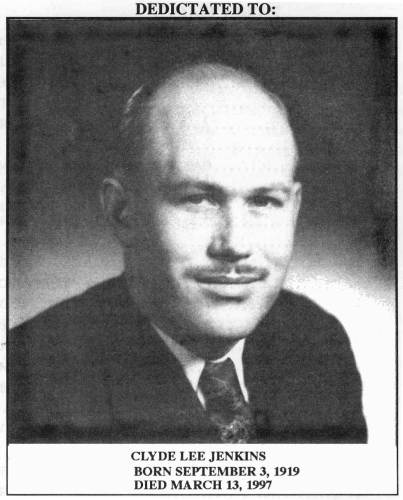
01 Clyde Lee Jenkins
Political unrest had gripped the nation in the
1850's and Miller County, still on the frontier, was not immune. While state's rights were
debated, the root of the unrest was slavery and whether new states would be admitted to
the Union as slave states or free states. Missouri's own admission to the union in 1824
had sparked fierce debate on the issue.
It is hard to believe no newspapers had been founded in
Miller County by the 1850's. Newspapers usually lost money, with the "editor"
making his income from "job printing," producing sale bills, calling cards,
stationery, receipts and so forth. The editor usually was also the ad salesman,
typesetter, reporter and job printer. However, if any such operations cropped up in the
area, they were of short duration.
In the 1800's type was set by hand. The typesetter held a
"stick," which would hold several lines of type, pulling individual letters from
a California job case (photo 02).
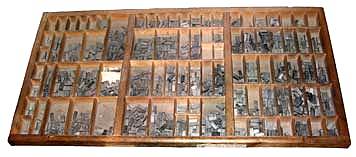
02 California Job Case
The typesetter was working upside down and backwards
as printing in those days was a mirror image of the type. Today, those cases are sought
after as antiques, often converted to display items, either on a wall or, with the
addition of legs, as a glass topped table. "Copy," or new and advertising items,
were written by hand and the typesetter worked from that. A 30 pica line drawn, or simply
the numerals 30, indicated when one item stopped and another began (a pica is about 1/6th
of an inch).
"Bloody Kansas" had erupted into open warfare
between slave interests and abolitionists by the election of 1856, and the unrest spread
into Missouri. The Democrats nominated Buchanan and the party platform opposed federal
interference in slavery. John Fremont ran for the still new Republican Party and Millard
Fillmore ran on the Know Nothing ticket. Buchanan was the favored candidate in Miller
County.
By 1860, the National Democratic Party had split in to the
Southern Democrats and the Northern Democrats over slavery. The Constitutional Union Party
had been formed and the Republicans had completely replaced the Whigs. The 1860
presidential election had four candidates: Abraham Lincoln, the Republican, was the
eventual winner, as we all know. He had only 23 votes in Miller County, where there still
were a fair number of slave owners. Those 23 voters for Honest Abe probably kept mum about
who they voted for as "Black Republicans;" they were not well thought of in
Miller County at the time. The Northern Democrats had 94 votes for Stephen Douglas, the
Constitutional Union had 193 votes for John Bell and Southern Democrat candidate John
Breckenridge had 495 Miller County votes. It can be construed that more than 60 percent of
the adult male population in Miller County favored the southern cause and eventually
secession. Women, of course, could not vote.
As the nation dissolved into Civil War, Miller County fell
into general lawlessness for most of the next five years. At first, secession forces, and
sympathies, had the upper hand in Miller County, though there were many loyal to the Union
and some families were split by the issue. A number of families simply left the area
because of the unrest and danger. Excesses by southern sympathizers and guerillas
eventually hardened much of the remaining local population against the southern cause,
even though occasionally the Federals did much the same thing. Losing livestock, grain and
food stores to guerillas and sometimes having their homes and farm buildings torched by
them as well was more than hardworking farmers could bear. At one point, 45,000 Union
troops were headquartered in Central Missouri, testament to how much the United States
military wanted to keep Missouri on the Federal side.
The Civil War left none of Miller County untouched.
General Sterling Price's Confederates rampaged across north Miller County at one
point.
Guerillas operated generally south of the river and
around Tuscumbia. The worst of those was a man known as "General Crabtree." I
have been unable to find a man named Crabtree who was officially a general in the
Confederate Army. It is possible that Crabtree either held a different rank, did not use
his real name, or that he had nothing to do with the Southern army other than claim to be
in the Confederate Army. He may have just been a criminal who disguised himself and his
men as Confederate. There were those attesting to be loyal to the Southern cause but using
the war as a cover for criminal behavior, and their crimes continued beyond the end of the
war. After the war ended, bands of marauders and bushwhackers roamed the countryside,
widows and their children often went hungry as their husbands and fathers had been killed
in the war and neighbors, and even brothers, who had fought on opposite sides continued to
carry grudges. The deep seated loyalty to the Republican Party in Miller County doubtless
has roots in the Civil War and the aftermath.
Depression Comes
During the 1880's, the country was in a depression and the
Democratic Party was taking the blame as it held both the White House and Congress. The
Autogram, established in 1883, was filled with sheriff's sales and foreclosures, sometimes
running more than its customary four pages to include them. Those who lost homes and farms
to bad economic times would be prone to blame the Democrats.
In 1885, the Autogram moved its offices to Tuscumbia. It
was a thoroughly Republican paper. Regularly the editor and publisher denounced the
editors and publishers of other publications and proclaimed itself to be the only
Republican paper in Miller County. Also in existence at that time were the Miller County
Vindicator, the Iberia Advocate and the Aurora Springs Messenger, which was founded in
1887.
Most small papers of the era seemed to be supported by one
political party or another, not just merely giving their support to one party over the
other. Donations were made by political operatives to the newspaper coffers. In 1884, the
Autogram editor reviled the Cole County Democrat, a newspaper that apparently was in
general circulation in at least part of Miller County. Another barb was made about
"Democratic print shops" in reference to the Vindicator.
Two of the county judges, now known as county
commissioners, were Democratic and two were Republicans. In the next election the
Democrats were turned out and Republicans elected.
In looking at a couple of years worth of old 1880's
Autograms that we have on microfilm in the office, I was amazed, actually appalled at the
nastiness of editorials and even news articles. Some of the names other newspaper editors
and political candidates were called, and the acts they were accused of, would earn a
modern day editor a suit for libel. Even the community correspondents got in on the act,
and letters of rebuke were published in the newspaper the week following particularly
spiteful attacks. Newspapers regularly accused their competitors of being bribed by one
party or the other, while they were taking such contributions themselves. The issue of
prohibition was important in the late 1800's and early part of the 20th century.
Therefore, certain candidates were called drunks or were given the nickname
"Bourbon" in the editorials.
In addition to the Republican and Democratic parties there
also was a People's Party active in Miller County in the 1880's. That name survived
through the 1970's in Eldon city elections. It disappeared after the city elections in
Eldon became nonpolitical. There also were occasional independent candidates for county
office.
In September 1886, the district Republican convention was
held in Rolla to nominate a candidate for Congress. Apparently political campaigns of that
era were blissfully short!
In November 1886, some Democrats won county offices though
on statewide races, there were 222 more GOP votes cast in Miller County than Democratic.
In 1888, with economic hard times still gripping the country, the county elected all
Republican office holders, though in the first district, the Republican county judge won
by only 60 votes. South of the Osage River, the second district candidate had 210 more
votes than the Democrat.
Eldon had been founded in 1882 when the Missouri Pacific
Railroad branch line from Jefferson City to Bagnell was laid out. But Olean and Aurora
Springs were much larger towns for many years. Eldon was not incorporated until 1904, the
same year the Rock Island Rail Line was completed through north Miller County.
Since the late 1880's there have been few Democratic
office holders elected in Miller County. Some Democrats have held county office by
appointment of a Democratic a Democratic governor to complete unexpired terms. It would
appear the terror Crabtree and other Southern cause individuals or groups perpetrated on
Miller County during the Civil War and a lingering depression in the 1850's turned Miller
County into a solidly Republican county. But nearby Morgan County, which had gone through
the same kinds of troubles, continued to have a solid Democratic Party and has often
elected Democratic candidates to office. In the latter part of the 1800's, mechanical
typesetting machines were invented. It was not until 1915 that such a machine
made it into Miller County newspaper work, purchased for the Eldon Advertiser. It was hot
work, with type cast from a lead pot kept hot enough to keep the metal molten.
Variety of News Sources
For many years, from 1875 through the early 1900's, a
German language newspaper, the Missouri Volksfreund, was published in Jefferson City,
serving the large number of German immigrants and their descendants who settled in the
Osage and Missouri river valleys, and many St. Elizabeth area residents subscribed. Dale
Doerhoff of St. Elizabeth and his daughter, Erica, have written a wonderful book, "A
Trip to Charleytown" (photo 05) about letters and other submissions to that paper from the St.
Elizabeth Community and I recommend reading it.
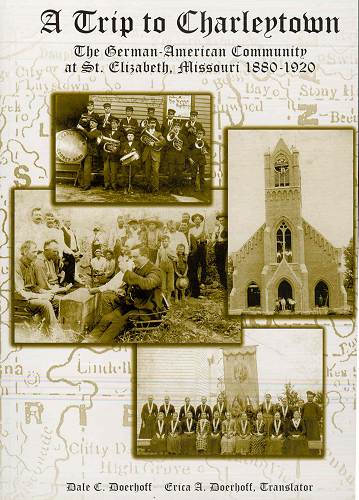
05 A Trip to Charleytown
Click image for larger view
German language newspapers also were published in
St. Louis and my husband's Swiss grandparents, who spoke German, subscribed to one, again
dropping their subscription during the First World War so as not to be thought of as
supporters of the Kaiser. The Volksfreund survived until 1925.
Other newspapers were sent to subscribers in Miller County
as well. They came from nearby Jefferson City and the St. Louis and Kansas City area. Some
daily newspapers also had weekly versions that were designed for outstate Missouri
readers. For many years, the Kansas City Star weekly had a featured quilt pattern in it.
In modern times, many residents take a daily paper, with
the Jefferson City News Tribune, St. Louis Post Dispatch, Kansas City Star and Lake Sun Leader, all popular in
the north part of the county. The Springfield
News Leader also is popular with some. Lake area residents who have moved in from one
metropolitan area or the other probably continue to subscribe to a newspaper from their
former home. There are deliveries of the New
York Times and Wall Street
Journal in the area. The national daily, USA Today is available locally, too. South Miller County residents
also take the Jefferson City daily paper, Lake Sun, Springfield paper and Waynesville Daily Guide.
Internet versions of those newspapers and others are undoubtedly viewed by residents.
Weekly papers have been the predominant news organs published locally, though from time to
time there have been efforts to start a local daily. The Eldon Advertiser was founded on
June 11, 1894, shortly after the Aurora Springs Messenger was moved to Tuscumbia. The
Advertiser continued to be a part of a commercial printing operation until Wallace Vernon
joined the operation in 1948 as a partner. He and wife Marjorie became sole owners in
1958. They acquired the Autogram in the 1950's and later added the Iberia Sentinel to the
company holdings and merged the Tuscumbia and Iberia papers into the Autogram- Sentinel.
Still today, people living in Tuscumbia are likely to shorten the name to Autogram while
people living in Iberia are likely to shorten it to Sentinel.
 |
Eventually,
commercial, or job, printing became less important and Eldon Printing Company was phased
out of the Vernon's operation. But it is hard for community papers to survive on their
own. Many are part of newspaper groups owned by larger corporations. Some maintain
lucrative commercial printing operations with a prime example being the Washington Missourian and the
parent owner of the Jefferson City newspapers. The
Vernon family has chosen to concentrate on weekly newspapers and Vernon Publishing Inc. is a
small, family owned newspaper group. The newspapers they own and print are the Eldon Advertiser, Miller County
Autogram-Sentinel, Versailles Leader Statesman,
the Morgan County Press
(Stover, Missouri), Tipton Times,
and the Highway Five Beacon
(Laurie, Missouri). Dane and Sharene Vernon are now publishers of the papers and Dane has
been president of the company since 1992. The third generation has joined the company;
Dane and Sharene's son Trevor is business and office manager for the Eldon Advertiser and
Miller County Autogram-Sentinel.
Neither paper has a history of supporting one candidate
over the other, though from time to time it has endorsed candidates. Some were Democrats,
some were Republicans. |
Technological Changes
Technology in publishing is rapidly changing. Eventually,
typewriters replaced handwritten copy in the printing industry. Still, that 30 mark was
used at the end of stories, signaling the typesetter, and actually was in common use in
the news industry until the 1980's. Those of us who use it now are dating ourselves. In
the late 1960's, the Vernon newspapers were converted to "cold type" and a new
offset web press was installed. More photos were introduced into the newspapers at that
time. No longer did they have to be sent off to Jefferson City for engraving but could be
produced quickly and relatively inexpensively in house. A 1970's Goss press, rebuilt and
enlarged several years ago is still in operation at our Eldon office (photo 06).
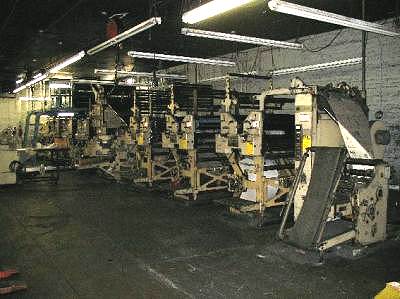
06 Goss Printer
At first, a typewriter driven device prepared
the type for photo engraving on a thin aluminum press plate. Gradually, computerized
typesetting was adopted and today the staff uses computers to create entire newspaper
pages and then produce the negatives used to engrave the printing plates. "We also
transmit portions of the Versailles, Stover, Tipton and Laurie papers to the Eldon plant
via the Internet. Many of our correspondents and other news sources send us their
information via the Internet.
The computers also allow us to make color
separations for photos easily, and you have noticed Vernon Publishing newspapers are
getting more colorful, particularly on the front and back pages of sections.
Changing Climate
Just as the newspaper industry is constantly changing,
politics is constantly changing. Today, Republicans do not have the strangle hold on the
county that is generally assumed, if one looks at election results from statewide and
national contests. There have been several Democrats elected to the first district (north
district) county commission seat since the late 1880's. And Miller County nearly always
voted in favor of the late congressman Dick Ichord (photo 08) and for Representative
Ike Skelton (photo 09), until the county was removed from Skelton's district and placed
in another. Ichord was a conservative Democrat, and so is Skelton.
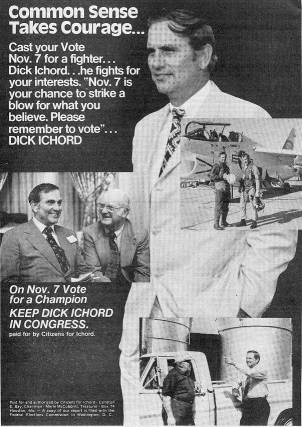
08 Dick Ichord
Click image for larger view

09 Ike Skelton
In the most recent general election, Democrat Judy
Prince, who was serving as the county treasurer by appointment, ran a tight race with
Republican challenger and winner, Phil Lawson. Lawson, of Tuscumbia, won 4495 to 4195.
Lawson had 51.7 percent of the vote.
For many years, Ronald Humphrey was mayor of Iberia.
Although city candidates do not run by parties, Humphrey is not shy about being a
Democrat. Buster McGowin told me a couple of months ago that one of his favorite things is
to join a regular coffee group at Brumley which is about evenly divided between Democrats
and Republicans. He enjoys the lively but mostly good spirited debates.
The Democratic Party probably has erred in simply writing
Miller County off for the most part in the last 20 or 30 years. The Republican Party has
probably erred in thinking Miller County will always be a lock for it. Nationwide, until
President Ronald Reagan's terms of office, union members were most often Democrats, and
precinct results in Miller county show far more Democratic votes were cast north of the
river than south. Because of the two railroads at Eldon and headquarters for Missouri
Utilities (which became Union Electric and finally AmerenUE) and Southwestern Bell
Telephone were headquartered in Eldon, large numbers of Democrats lived in the north part
of Miller County as those companies had union employees. Such union influence was less
likely in the south part of the county.
While the railroads have been totally gone from Miller
County since 1979, their influence has not completely dissipated.
The Democrats hold on Union members has slipped
nationwide, and the same has been true in Miller County. In the 21st Century, homegrown
union members tend to be Republican in Miller County at least. That is particularly true
of members of the carpenters', laborers' and operating engineers' and other unions
associated with the construction industry. It's been my observation that union members who
have transferred in from other areas are more likely to be Democratic, particularly if
they are associated with the International Brotherhood of Electrical Workers, the
Teamsters and other large national unions.
Until the patronage system in Missouri was mostly done
away with in state government, there also were people who switched parties every time the
state house went from one party to another. It was the only way to hold onto their state
jobs. In the privacy of the voting booth, it is likely those people continued to vote
their party or candidate preference during general elections, though they had to be
careful about which primary they voted in.
Modern Elections
In the modern era of Miller County elections, the November
3, 1960 editions of the Miller County Autogram-Sentinel and Eldon Advertiser noted the
presidential race was expected to generate heavy voter turnout on November (The Tuscumbia
Autogram and Iberia Sentinel had been merged on April 2, 1959). The November 10, 1960
issue of the papers said the "county went Republican again." There was a record
vote of 6705. Nixon received 4249 votes in Miller County while Democrat Kennedy earned
2456, a not quite 2 to 1 margin. There were more Democrat votes cast in the Missouri
Governor's race. The Republican, Farmer, had 3771 votes while the Democrat, Irwin, was
less than a thousand behind at 2827.
1968 was a time of civil and political unrest in the
country as the Vietnam War heated up and we were watching it on television night after
night. The October 31, 1968 issues of the Vernon newspapers noted "political fever
reaching a high pitch." The November 5, 1968 election saw Miller County go Republican
"all the way," as the local newspapers attested. Hubert Humphrey had 1650 votes
in Miller County, with 600 of those coming from the three Eldon wards and another 225 from
the two Iberia city precincts. Nixon had 4102 votes countywide and Wallace, the
independent running in favor of segregation, had 620 in Miller County.
Hearnes, the Democrat, had 2585 in the 1968 gubernatorial
race. Republican Roos had 3662. In the area Congressional race, Ichord had 2497 votes
while Republican Northern had 3613 in 1968.
Four years later, civil unrest over the war was peaking.
On November 7, 1972, 78 percent of Miller County voters went for Nixon; McGovern did less
well than Humphrey had done four years before, getting only 1598 votes in Miller County.
About 720 of those votes-close to half-came from the city wards of Eldon and Iberia.
That year Democrat Ichord had the hearts of Miller County
voters. He had 4120 votes in Miller County, besting Republican Countie, who had 3105.
Interestingly enough, Doug Griswold, ran for coroner in 1968 as a Democrat. He got 3205
votes, although Republican Paul Yarger won with 3882 votes. Griswold later ran
successfully many times, but on the GOP ticket.
In the most recent Presidential race, the Kerry/Edwards
ticket had 2956 votes on November 4, 2004. The Bush/Cheney ticket had 7795 votes as
Republicans. Democrat Clair McCaskill did better, taking 3369 votes that year as she
sought the Missouri statehouse. Matt Blunt, the GOP winner, had 7327 votes in Miller
County, a better than 2 to 1 difference. Interestingly, Democratic Attorney General Jay
Nixon, running for re-election, won in Miller County with 5388 votes. Challenger Chris
Byrd was not far behind with 5016. County voters obviously were splitting their tickets.
Starting with the lst general election, November 7, straight party voting is no longer
possible with a single mark in Missouri but a voter must make a mark beside the name of
each candidate they are voting for.
Quiet Democrats
Many Miller County Democrats simply don't talk about their
political leanings much but in the privacy of the voting booth they express them. I'm also
cynical enough to believe that many candidates have run here on the Republican ticket even
though their leanings were Democrat. A great many local Democrats vote in the Republican
Primary Election every other August in Miller County, because that is the only way they
can have an influence on county elections with few Democrats ever running and a race in
local Democratic Primary elections even more rare. Voting in any party's primary election
is possible because in Missouri voters are not registered by party, but simply registered
to vote.
Miller County Clerk Clayton Jenkins (photo 10) told
me that he has observed a lessening of the number of straight party ballots voted in
Miller County and many voters split their tickets prior to the rule change this year.
Ballot order does not seem to play a role, either, in Jenkins' observations. That may be
due, in part, to a better educated electorate and a lessening of illiteracy not only here
but nationwide.

10 Clayton Jenkins
Miller County voters have always been prone to
"pick and choose" between candidates and the parties, Jenkins said. "Miller
County voters are very smart. They study the issues and the ballots," he said in
October. The cited elections seem to ber that out.
Party loyalty also is waning nationwide, at least
according to both the Republican and Democratic parties. A viable third party may
eventually arise to take the place of one of those parties just as the Republicans arose
in the 1850's and caused the Whigs to disappear. As we all know, in politics, anything can
happen.
Thanks Ginny for that very comprehensive survey of Miller County history, politics and
newspapers!
Ginny mentioned that Vernon Publishing no longer does commercial work. We were very
grateful several years ago to have received an antique card printing machine from Wallace
Vernon. It is on display in our museum (photo 11).
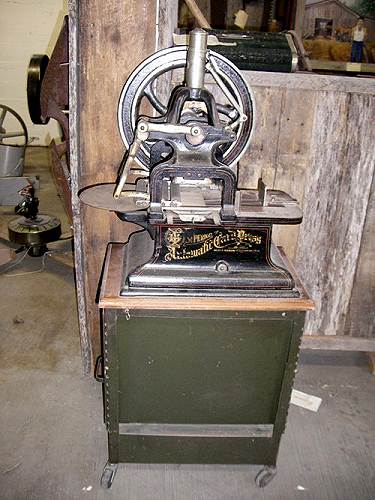
11 Card Press
This is the narrative which is on a card attached to the press in our museum:
Superior Automatic Card Press
This vintage piece of printing equipment, presented to the Miller County Historical Museum by Mr. and Mrs. Wallace Vernon, was purchased by their employees from Dewey Kallenbach as a Christmas gift some years ago. It was displayed in the front offices of Vernon Publishing, Inc. in Eldon for a number of years.
Although the origin of this particular press is uncertain, either this one or a similar one was stored in the offices of the Miller County Autogram in Tuscumbia at the time of its purchase by Dorsey Barron and Basil Bassman in the 1930's. The former owners, Stillwell and Wright, had asked to keep that press as a memento and the press was passed on to either Lloyd or Gerald Wright when Barron and Bassman later sold the newspaper.
Mr. Barron recalls that Kallenbach told him at a later date that he had purchased the press from Charles Tellman, a prominent farmer on the Osage River at the time.
Nancy Thompson, our museum director, this week found an old Olean newspaper that
was stashed away in a collection of items donated long ago to the museum which has been
very interesting to read. It was named the "Miller County News." You can go to
it now if you wish on our website at:
http://www.millercountymuseum.org/moreoldnews.html
However, I will copy here a couple of articles from this old newspaper which has
pertinence to Ginny's topic, the history of newspapers in the county. The first article
was a list and description of the current newspapers published in Miller County at the
time of publication of the old newspaper in 1899:
THE PRESS OF THE COUNTY
Miller County has five weekly newspapers, all of which
merit the substantial support given them.
1. The News is an eight-page, five-column paper, published
at Olean. It was established nearly nine years ago, has a bonafide circulation of nearly
six hundred and claims to have the finest equipped job office in any country town in
Central Missouri. Politically, it is a straight-out Republican. W.E. Allen is proprietor
and H.A. Bradleyford local editor and business manager.
2. The Autogram is published at Tuscumbia by Mord.
McBride. It is the oldest paper in the county and Mr. McBride is one of the founders. The
paper was first established at Aurora Springs but was moved to Tuscumbia about twelve
years ago. It is a five-column, eight-page paper and staunchly Republican.
3. The Impetus is owned, edited and published at Iberia by
Dan Frazer Thompson, who has run more papers in Missouri than any one else, and is the
only paper in Miller County published south of the Osage River. It is a neat five-column
folio and deserves and receives a substantial patronage from the business men of Miller
County's metropolis.
4. The Record is edited and published at Tuscumbia by
Warren M. Barr, who is also a lawyer, and figures prominently in local politics. It is the
only all-at-home-print paper in the county and is Democratic from the word "go".
5. The Advertiser at Eldon is published every Thursday by
Maude and Rawleigh Shepherd and edited by N.J. Shepherd, who is also a well known
contributor to the leading agricultural papers in the west. The paper is independent
politically and devotes its efforts to give the local news. It is a five-column quarto and
receives a good patronage from the business me of the town in which it is published.
6. The Western Preacher is a 16-page religious monthly
published at Tuscumbia by James P. Wright and edited by Eld. H. Crennen, of Seymour, Mo.
Mr. Wright is one of the oldest printers in the county and has probably been in the
business longer continuously than any man now engaged in the printing business in Miller
County.
The second article from the old "Miller County
News" of Olean lists former newspapers published in the county but which had gone out
of circulation by 1899. Some of the words in this article could not be read clearly due to
the crumbling away of the old paper material; so you will find occasional blank places
where this occurred:
FORMER MILLER COUNTY NEWSPAPERS
Since 1870, eleven newspapers have been established in
Miller County that are now numbered among the has-beens. The first paper established in
Miller County was by Lemmon and Hitchcock who ran the paper from 1871 to 1875, the name
being the Osage Valley Sentinel.
In the year of 1871, Mc-stin, ---nght started The
Republican, and sold it in a few months to I.M. Goodrich of Tuscumbia who sold the outfit
to a Mr. Vincent of Lin Creek and with this outfit the first issue of The Stette, Camden
County's first newspaper was printed. The good reliable Reveille succeeded the Stette and
Mr. J.W. Vincent, the present editor, is the son of the founder of Camden County's first
paper.
In 1872 J.P. Wright and J.H.D. Thomson founded The Gospel
Proclamation, a religious monthly. This paper continued for several years-up until
1874-when Mr. Wright bought the interest of Mr. Thomson and made the paper a Republican
paper and issued it weekly. This was The Miller County Vindicator. This paper suspended
publication in 1888 and a few months later with this outfit D.F. Thomson established The
Eye-Opener, of which The Osage Valley Record is the successor.
The Miller County Vidette was established in 1872 and
continued for about three years with Rudolph Goodrich as editor for the first year and
Col. Abram Fulkerson as editor the last two years of the paper's existence. The outfit was
purchased by J.M. Goodrich in 1878 and sold to Richland parties.
The Helmet was established at Tuscumbia as a Republican
paper by L.S. Hitchcock. Later it was purchased by F.A. Goodrich and Col. Abram Fulkerson
who changed the name to The Miller County Republican. This management continued through
one campaign when the outfit was sold and the subscription list and good will was turned
over to the Vindicator.
The Iberia Advocate was established in 1885 by a Mr.
Lohman but the town was too small to support a paper and in a few months it suspended.
The Messenger at Aurora Springs, established by J.F.
Mounts and survived from May 1896 until November 1897 at which time the plant was moved to
Versailles and The Statesman established.
The Democrat, by Ol? Klinger was established at Aurora
Springs in 1888 but was short lived and was suspended in 1889.
The Aurora Cresset was established by Abram Fulkerson at
the Springs in 1881 and continued until The Eldon Register, by A.C. Harding was
established. This paper was replaced by the establishment of The Aurora Springs Autogram
by McBride and Marcy, which has since been moved to Tuscumbia and still continues to
promulgate the principals of Republicanism.
The finding of the old copy of the Olean "Miller County News" this week
really added some interesting information to the topic of Miller County newspapers so well
summarized by Ginny Duffield. But be sure and go to our website
which I listed above and read the entire edition of this old paper as it summarized the
stories of many of the prominent men and businesses of Olean in 1899.
Ginny pointed out in her narrative that Miller County was divided in its loyalties
between the North and South leading up to the Civil War. Even before the war involved the
county, discord was beginning to occur among families sympathetic to one or the other
cause. Missouri Governor Jackson was a Southern sympathizer as was General Price, head of the State Guard. A significant conflict in the state began when Union loyalist U.S. Army General Lyons
of St. Louis recruited several thousand German immigrants in St. Louis, all Union
supporters, to attack Camp Jackson, where a large number of State Guard troops were
located. News of this event infuriated Southern sympathizers in Miller County and a
vendetta began by them against the German settlers who had come up the Missouri and the
Osage rivers to settle farms along the rivers. Most Miller Countians with family roots
going back to this era can remember stories of violence involving their ancestors whether
of Southern or Northern persuasion.
At the time, most of the county was sympathetic to the Southern cause. Clyde Lee
Jenkins reports that old census records indicate that at various times before the Civil
War 230 to 250 slaves were present in the county. Oaths of allegiance were demanded by
Southern sympathizers from German immigrants and others who were suspected of supporting
the North. Violent encounters became more and more frequent. For protection, Northern
sympathizers organized a "Home Guard" to defend against the already established
"State Guard," the official state army of Missouri, but which was under the
direction of Southern sympathizer, General Price. In addition to the friction among local
families in Miller County another increasingly significant problem was the ever increasing
number of "bushwhackers," Southern sympathizers, who raided and pillaged local
farms and families to steal supplies for the Southern forces.
Ginny mentioned in her narrative the infamous "General Crabtree," who
according to Clyde Lee Jenkins, "killed more people, burned more buildings, stole and
destroyed more property, than any man in Miller County before or since the Civil War"
(History of Miller County p. 453). Clyde reported that "Crabtree's cruelty made a
deep impression on the minds of the inhabitants. Long after he was shot and his life
ceased, impatient mothers would bring their children to obedience with the threat of
'Hush, Crabtree is coming (ibid. p. 438)!'"
As Ginny reported, no evidence exists that Crabtree was a true Southern Army general.
However, references to him can be found on the internet characterizing him as an operative
under General Price as well as having associated himself with William Quantrill.
According to an article written by Richard Antweiler in Missouri Life/November
'81/43, "Crabtree never became famous, probably because he limited himself to a small
geographic area. And because he did, the same poor people were picked on time after time.
It was this disgruntled group of victims that finally saw the "General" to his
death," (as Peggy Hake will describe a little later in this narrative).
Antweiler continues about Crabtree: "Though dubbed "General" no army
would claim him. A small time profiteer of the central Missouri area, he used the same
cold-blooded tactics as his more storied counterparts (ie: Quantrill, the James brothers,
and the Younger gang)."
Clyde Lee says that Crabtree's cruelty and the devastation he wrought in the County
more than anything else, is what changed Miller County from being so sympathetic to the
Southern cause. Originally, Miller County heavily voted against Lincoln in his first
election and in the beginning of the North/South division flew a confederate flag at the
Courthouse. But the devastation caused by those claiming to be Southern sympathizers (but
in many cases were common criminals) significantly influenced the opinions and feelings of
many of the county's citizens.
One especially cruel act committed by Crabtree was the massacre at Curtman Island. I
copy below Peggy Hake's narrative of this event:
MASSACRE ON CURTMAN ISLAND, MILLER COUNTY, MISSOURI
by Peggy Smith Hake
The Civil War years in central Missouri were times
of great distress and at times, pure terror. Missouri was a controversial state during the
war. In fact, it has been said Missouri fought her own Civil War. It was a borderline
state where the people simply could not decide which side to fight for. There were
pioneers who had migrated from the southern states of Tennessee, Virginia, Kentucky,
Georgia, and the Carolinas and they, naturally, tended to support the Confederacy. Another
faction of pioneers came from the northern states of Pennsylvania, Ohio, and New England.
The Union Army was often infiltrated by men who actually favored the South, but joined the
Northern armies because they knew they would get a monthly pay voucher....the Southern
Army was much poorer!
Guerilla forces, called bushwhackers, were very
prevalent in Missouri. Some of the bandits of central Missouri were actually an arm of
Quantrill's Raiders who terrorized all of Missouri and Kansas. Their atrocities are well
documented in the history of the Civil War. A Confederate general named Crabtree and his
raiders ran rampant in the central Missouri area and especially in the region of southern
Cole and northern Miller counties. He and his forces had their local headquarters in caves
along the Osage River near the old railroad town of Hoecker in northeast Miller County. At
first, Crabtree's intent was to round up able-bodied men so they could be sent on to
southern Missouri, near the Arkansas border, to join General Sterling Price's army. He
recruited many men for this cause but after awhile, it seemed his greater pleasure was
terrorizing the local residents and their families. His band of marauders began to steal
and plunder anything they could get their hands on....horses, livestock, wagons, food, and
provisions. High on his priority list was grain sheds and smokehouses where the farmers
had stored cultivated crops and meat supplies. Many homes, barns, crops, etc. were torched
and burned to the ground. It was not beneath him to torture families in order to get
information about military activities in the area....he was also interested in their
valuables and where they were hidden.
After some time, area-wide enrolled militias were
organized. One of these militia groups, the Provisional Company of Mt. Pleasant-Missouri
Militia, was commanded by Capt. Thomas Babcock who operated from the small village of Mt.
Pleasant, Saline township, Miller County. Capt. Babcock kept his men on Crabtree's trail
constantly. In the second week of August 1864, one of Crabtree's men, John P. Wilcox, was
captured and sent to Jefferson City. He was tried for war crimes by a military commission
and was ordered executed. The execution was carried out immediately ... Receiving word of
the execution of one of his men, Crabtree sent his band of guerillas out on rampaging
maneuvers ... plundering, burning, and killing.
In late August 1864, Babcock sent sixteen of his
men out again looking for Crabtree in his own 'backyard' in the Wet Bottom region of the
Big Tavern creek. On August 30, they reached Curtman Island, located in the middle of the
Osage River near where the Big Tavern creek empties into the Osage. The men were under the
command of First Lt. John Starling. At the noon hour, the militiamen stacked their weapons
and relaxed for awhile, enjoying their meager provisions. That was a tragic mistake!
Suddenly, about 25 of Crabtree's men surrounded them. Seven of the sixteen men were
ordered to line up on the sandy soil of the island. Those picked were Lt. John Starling,
William Gibson, Samuel McClure, Yancy Roark, Pharoah B. Long, Nathaniel Hicks, and Stephen
S. Crisp. Hicks and Crisp were brothers-in-law. The seven were executed on the spot by
gunfire. The other nine men, including Boyd S. Miller and Joseph Hicks, were told to run
and not look back till they got to Mt. Pleasant and when they got there to tell Babcock
that "Crabtree was responsible for the execution of the seven men".
A group of the militia returned to the island to
bring the bodies of the soldiers back to their families for burial. Only six were found.
At a later time, the bones of the seventh man were found on the island. Evidently he had
crawled some distance away from his comrades before death overtook him.
This cruel episode was the beginning of the end for
General Crabtree. The execution of the seven men on Curtman Island was an act of revenge
by Crabtree, but he seemed to know it was a drastic mistake and went into hiding in the
various caves and hollows of the Big Tavern country.
After awhile, Crabtree and some of his men ventured
into the Teal Bottom area of the Osage near present-day St. Thomas (Cole County). Once
again, they started their pillaging, destroying, and robbing the countryside. At the farm
of Herman Scheuler not only did they take provisions, but Crabtree stole Herman's new
wedding suit! Scheuler was outraged and started tracking Crabtree with the aid of his
half-brother, Adolph Loethen, and neighbors, Bernard Bax, Michael Gerling, and Jim Clark.
They followed him for several days, finally tracking him to an old barn in Teal Bottom.
Herman and Adolph, very cautiously, made their way through corn rows and to the barn. Just
as they were ready to shoot through the barn door, they were jumped by two sentry dogs.
Adolph got off one shot in the melee' and hit something....He and Herman turned and ran
for their lives, not having any idea what or who had been shot. The next morning all five
men went back to the barn and found that one of Crabtree's horses had been shot in the
eye. What they didn't realize at the time was the bullet from Adolph's gun had first hit
Crabtree and then hit a timber in the barn before it finally hit the horse...
The men continued to look for Crabtree and finally
tracked him to the cave along the Osage (later called Crabtree Cave). They were sure they
had him surrounded, but all they found was a woman who claimed to be his wife. She
screamed at the men and said, "You have killed my man". She finally admitted his
men had carried him toward Spring Garden to the northwest. They hit the trail once again
and eventually captured five of Crabtree's men. They took Herman and his small posse to
the place where they had buried Crabtree. Even in those days, being typical Missouri
citizens, the men wouldn't believe it unless they could "be shown!" They dug up
the fresh grave and, sure enough, the old bushwhacking southern general was lying in a
makeshift grave and laid out in Herman Schueler's brand new wedding suit… Talk about
angry, those folks took their weddings seriously! In 1969, white government military
stones were erected at Allen Cemetery, located just east of Olean, in memory of the seven
men who died on Curtman Island. All of the seven are not buried there even though the
stones were put in the cemetery for seven soldiers. On each stone is the soldier's name
with the inscription "Pro Co Mo Mil" (Provisional Company Missouri Militia).
THE SEVEN SOLDIERS EXECUTED ON CURTMAN ISLAND IN
1864...
by Peggy Smith Hake
The following is a brief history of each of the
seven Union soldiers who were executed by General Crabtree's forces on Curtman Island on a
hot, sultry day in August, 1864...
1. STEPHEN S. CRISP was a son of Joseph and Phoebe
Crisp, natives of North Carolina. Stephen (called Dick) was born in Kentucky on 2 May 1838
and was 26 years old when he died. He married Elizabeth Mahala Bond (dau. of Joseph and
Charity Bond) in Miller County in 1862. They had one child, Mary Jane Crisp, born 1864.
Stephen's widow, Elizabeth (Bond) Crisp, later married Robert Hill and they had 6
children. Stephen is buried at Spring Garden cemetery in northern Saline township. His
brother-in-law, Nathaniel Hicks, who married Elizabeth Crisp, also died on Curtman Island.
2. WILLIAM GIBSON is a man of some mystery. Not
much is known about him. In Miller County marriage records, a man named William Gibson
married Martha Young in February 1841. They do not appear in census records, so it is not
known if he was the same man as the one massacred on Curtman Island. In 1860, Wiley
Gibson, his wife Mahala, and 5 children lived in Richwoods township. He was about 31 years
old, born in Tennessee c/1829. It is possible he could be the William killed by Crabtree's
raiders. It is a known fact that William Gibson, one of the 7 executed, is buried at Allen
cemetery near Olean.
3. NATHANIEL HICKS was born in Kentucky about 1837,
a son of Nathaniel Hicks Sr. and his wife, Lucinda. They were both natives of Virginia.
Nathaniel married Elizabeth Crisp, daughter of Joseph and Phoebe Crisp and a sister to
Stephen Crisp who also died on Curtman Island. Nathaniel and Elizabeth had at least three
sons: James L. Hicks, Joseph N. Hicks, and Stephen S. Hicks. Nathaniel died at the age of
27 years and is buried at Allen Cemetery near Olean. In December 1866, his widow,
Elizabeth, married John A. Tracy.
4. PHAROAH (Farrow) LONG was born in Tennessee
about 1832, a son of John Long (1801-1888) and his wife, Nancy ( 1804-1891), both natives
of North Carolina. He married Martha Hix/Hicks in Miller County in January 1851. They had
two daughters, Nancy J. Long and Jemima E. Long. Pharoah, called Farrah, died at the age
of 32 years and is buried at Allen cemetery where his parents are also buried. (Some have
not agreed that Pharoah is actually buried at Allen Cemetery.)
5. SAMUEL MCCLURE may have been a son of Anna
McClure, born c/1815 in Kentucky. No records have been found for him in Miller County
census records. He is buried at Allen Cemetery per cemetery inventory records and has a
military stone. Also at Allen Cemetery is William M. McClure (1852-1926). He may have been
a brother to Samuel. Some reports state he may be buried at Amos Cemetery in Moniteau
County.
6. YANCY ROARK was born in Kentucky on September 2,
1827, a son of William and Candace Roark. He was 36 years old when he died on Curtman
Island, just 3 days before his 37th birthday. In November 1849, Yancy married Leah Vernon
in Miller County and they had three children: Henry Nolan Roark, John B. Roark, and Martha
Roark. Yancy has two stones in Allen Cemetery; one that was placed by his family and the
other is a government-issued stone. His wife, Leah Vernon, Roark, never remarried but
remained his widow and died in 1907. She is buried at Eldon Cemetery as well as their
three children.
7. JOHN P. STARLING was a son of Thomas Day
Starling (1796-1880) and his wife, Elizabeth (1801-1872), natives of Maryland and
Tennessee, respectively. John was born in Tennessee on 24 March 1832 and was 32 years old
when killed. His wife's name was Sarah E. (maiden name unknown) and they had 4 children:
James Starling, William Starling, Samuel Starling, and Louisa J. Starling. John is buried
at Allen Cemetery where his family is also buried. John was the commanding officer in
charge the day they patroled Curtman Island. He held the rank of First Lt. of the
Provisional Company.
FOOTNOTE:
Curtman Island was named for Charles Nicholas Cary
Phillip Otto Curtman, who once owned the island before the Civil War. Charles was an
immigrant from Giessen, Hesse Darmstadt, Germany. He was a son of William J.G. Curtman and
Adelheid Kroenke and was born on July 27, 1829. Charles came to America in the early 1850s
and settled in Miller County. On June 24, 1852, he married Miss Sarah Boyd, a daughter of
James and Ruth (Clark) Boyd, natives of Greenup County, Kentucky. They had homesteaded in
the same general area about 1835. In 1854, Charles Curtman, who by profession was a
doctor, opened his medical practice at an early-day store on the west bank of the Osage
River, called Fairplay. He and Sarah had three children: Minna Ruth 1853-1855, William
1855-1857, and George Washington born 2 Nov 1857. Sarah Boyd Curtman died when George W.
Curtman was only 7 days old. George was the only surviving child of Sarah and Charles
Curtman. He followed in his father's footsteps, becoming a well-known physician in Miller
and Maries counties.
Thanks Peggy.
One of my relatives, John Bear (photo 16),
who was an uncle of my grandfather, Madison Bear, was captured by General Crabtree. He
was, however, a very fortunate man as this account by Clyde Lee of the story reveals
(History of Miller County p. 435):
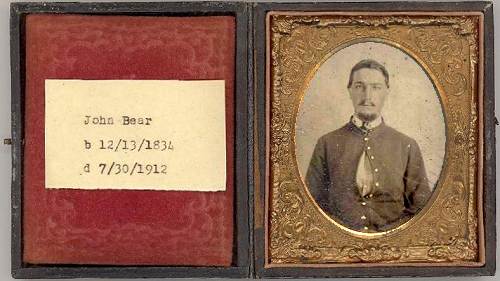
16 John Bear
Tuscumbia Captured
"The Confederate band (Crabtree's army) set
off like hounds in full cry south, down the ridge toward Tuscumbia. The next morning they
were entering into the County Seat, quietly spreading themselves over the village so that,
by personal observation, they might learn the exact strength of the place. When having
gained knowledge enough to know the people were quite off their guard, they fell upon the
unfortunate inhabitants, taking possession of the town without a struggle, immediately
plundering the stores, homes, and Courthouse, loading their horses with the booty.
The capture of the town being so sudden, no
preparation could be made for checking it, even by a number of Union Soldiers and
Militiamen in the place. The men folk of the town, about fifty in number, forced at
gunpoint to retire to the river bank, were lined up with their backs to the river. One
bearded gentleman determined when shot, he would pitch over the steep bank into the deep
water below.
Mike Wyrick said, "I knew my life wasn't worth
a plug nickel! With guns in my face, and men threatening and expected to use them, I was
standing on the very edge of the steep bank past the ferry landing, waiting to be shot and
lost in the current of the Osage."
Sergeant John Bear, captured by the men, was placed
upon a horse, his hands tied to the saddle horn. Anxiously inquiring as to the meaning and
purpose of his treatment, the men informed him he was their prisoner, "Besides,"
one of the men said, "you are the first "bear" we have captured for some
time, and will treat you no worse than the other wild critters in the woods."
The men folk of the village, having their weapons
taken from them, helplessly watched as their rifles and shotguns were bent and smashed
over the hull of a steamboat, moored by the warehouse; their side arms tossed into the
river.
Undoubtedly, the citizens would have been
sacrificed by the insaneness of the men had not a rider, galloping into the village, saved
them, for he carried information that a force of Militia, of about sixty horsemen, were
riding toward Tuscumbia from the north.
Immediately, at gun point, the men of the village,
along the river bank, swore an oath of Allegiance to the Confederacy. Then Crabtree's men
dispersed, taking Sergeant John Bear with them; afterward he was paroled, unharmed.
As the Militia charged through the village, in hot
pursuit of the fleeing confederates, the frightened people of Tuscumbia returned to their
looted homes and places of business."
The only reason I can think of that my great great uncle John Bear was released was
that Crabtree must not have been with his men that day, for as ruthless as he was, he had
no concern about dispensing with the lives of his captives.
Another family story of mine (and I know that about any of our Miller County natives
have their own family stories to tell about these very harrowing times in our history) was
also recorded in Clyde Lee's Volume 1 (page 423) having to do with how neighbor was turned
against neighbor due to the strong sentiments for either the Southern or Northern cause.
This story took place on the Bear family farm which was homesteaded by my great great
grandfather, George Bear (photo 17),
near the place where Coon Creek joins Dog Creek. The young Bear son was my great
grandfather, David C. Bear (photo 18):
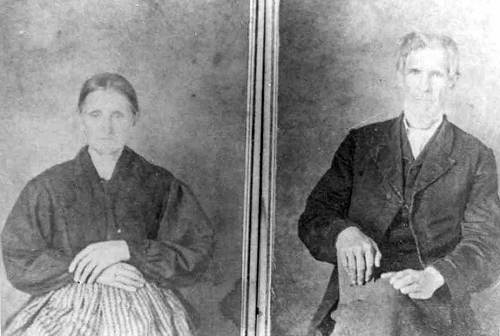
17 George and Elizabeth Bear
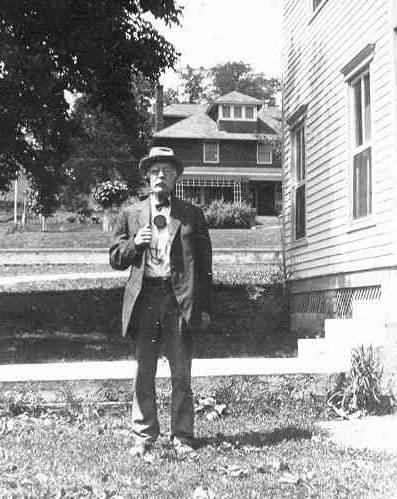
18 David Christian Bear
Bear Trap Set
Clyde Lee Jenkins
George Bear, living south of the Osage River in the
vicinity of the bend of the Dog Creek, being a strong Union man, viewed with pride the
record of his six sons in the Union armies.
His closest neighbor, John Martin, living approximately
one mile eastwardly, having sons in the Confederate Armies, was a dedicated rebel.
To say the least, during this time, these men were none
too neighborly, but their boys, each having an eight year old son in the home, were very
fond of each other. Often, the Bear and Martin youths met, usually in the woods, secretly,
where they discussed their mutual problems, earnestly, frankly, and honestly.
"My Pa is a rebel," the Martin youth informed
his playmate many times, for John Martin was leading a small band, bushwhacking south of
the Osage River. According to custom in that day, young Martin, in the log house of his
father, slept in an attic room floored with loose planks. He slept above the room where
John Martin met with the gang when planning raids upon the countryside. Eavesdropping
through a knot hole in a plank of the bedroom floor one night upon the proceedings in the
room below, young Martin over heard the gang planning a raid upon George Bear's farm the
following evening.
The young boy didn't like this at all, so very early the
next morning, he was in the woods above the Bear home, desperately whistling for his young
friend to come up. When at his side, Martin informed his playmate of the raid certain to
occur following sunset, who would be in the gang, and the things they were going to take.
With the falling of darkness, many Bears were in the
woods, on the prowl, armed and ready, but nothing happened!
At the breaking of dawn, on the ridge above the Bear home,
a shrill whistling was heard, and the two boys were soon together.
"The raid is off," young Martin said, "The
men met last night at my Pa's house, and they objected. They informed Pa of George Bear
having six sons in the Union Army, and asked Pa what he thought their hides would be worth
when the boys returned home? Pa hadn't thought of that, so the raid was called off!"
You can find the photos of the six Bear brothers who fought in the Civil War for the
North on our website at:
http://www.millercountymuseum.org/people/bio_b.html
You will have to scroll down the page a short distance to the article written by Marie
Bear Stillwell entitled: "Bear Family Photos Of Those Who Fought In The Civil
War."
We are continuing to fill the new addition to our museum with displays getting ready
for when we open in May. Diane Berkbigler has just filled a china cabinet (recently
refinished by Brice Kallenbach) with antique miniature children's tea sets (photo 19).

19 China Cabinet
Also, we were delighted that Sue Dillon of Jefferson City brought down to us a
display of miniature quilts she has made. Sue began quilting in 1986 and then turned her
attention to miniatures in 2000. These quilts require good eye hand coordination to sew
due to their small size. All are 24" by 24" or less and made up of fabric blocks
of 3 inches square or less and which quite often are old and not available any longer. We
very much appreciate the time involved for Sue to bring her collection of quilts down to
Tuscumbia but also for the meticulous manner in which she took the time to lay out and
place the quilts in our display case (photo 20
and photo 21).
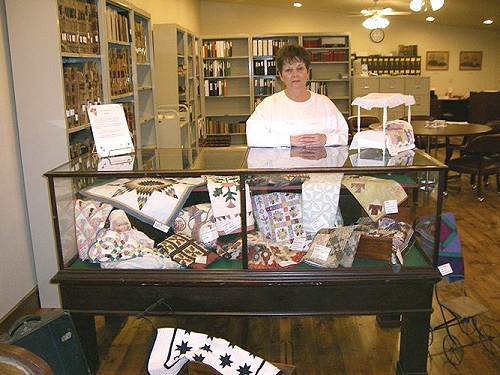
20 Sue Dillon
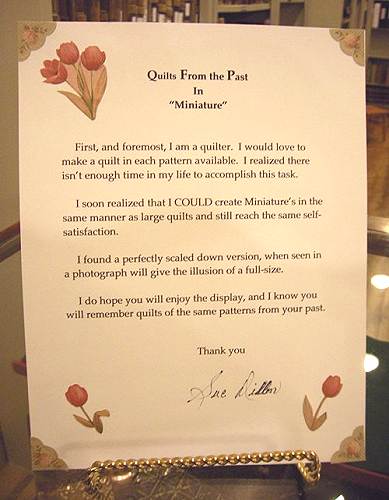
21 Sue Dillon's Story
David Statler, the website expert who we have retained as a consultant for uploading and fine tuning my weekly contribution to our website, was very interested in Sue's work. In fact, his father is an engineer who has designed a stitcher which bears his own name. I hadn't known about this before David, after reading what I wrote about Sue Dillon, sent me the following email:
Sue Dillon's quilt story was really neat. My father is really involved in the quilting industry. He researched, designed and invented what is now called the Statler Stitcher, which is a computer guided addition to long arm quilting machines. He has sold these machines all over the world. A few years ago, he sold the business to Gammill Quilting (located in West Plains, MO) and it has really taken off (my father still works for them though in their research and development department). He also goes to most of the major quilt shows around the country (my father and mother are both headed up to New Hampshire next week for the big show up there) to show off the machines, etc. You can find out more about it at their website:
http://www.statlerstitcher.com
That's all for this week.
| 


